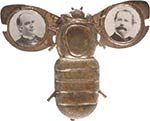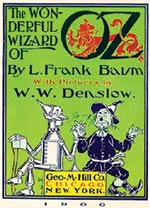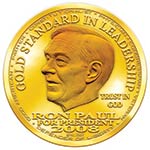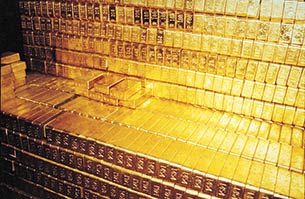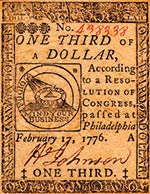
1775 The Continental Congress prints paper dollars backed by Spanish gold. Overprinting and hyperinflation render them “worthless as a Continental.” 1795 The US Mint produces its first gold coins, though most early American currency is silver. 1849 California Gold Rush increases supply of gold currency. |
1862 To pay for the Union war effort, the Treasury prints “greenbacks”—bills not backed by specie, prompting gold hoarding. The Confederacy says its money is backed by gold—when it turns out it’s not, the Confederate dollar’s value crashes. 1873 Amid a silver boom, the Coinage Act cuts back on the production of silver coins. Cash-strapped farmers and small businessmen, who’d hoped to pay off debts with “free silver,” brand the act “the Crime of 1873” and vilify gold as the choice of East Coast bankers. |
|
1893 Financial panic leads to a run on gold, which plunges the nation into a depression. The Treasury is left with devalued silver stock. Republicans blame pro-silver forces. 1896 William Jennings Bryan delivers his “Cross of Gold” speech, railing against gold and “the idle holders of idle capital” who back it. “Silver Democrats” square off against Republican “goldbugs.” 1900 The Gold Standard Act formally places the dollar on the gold standard. L. Frank Baum publishes The Wonderful Wizard of Oz, which some see as a political parable of the tensions between the supporters of gold and silver (the original color of Dorothy’s slippers). 1932 Wary of the incoming Roosevelt administration’s monetary policy, Americans withdraw $1.3 billion worth of gold from banks. 1933 To fight gold hoarding, Congress authorizes an executive order making the possession of gold coins and bullion a felony. Alarmed, FDR’s budget director warns, “This is the end of Western civilization!” The gold standard is temporarily suspended in an effort to beat back deflation. 1937 Most of the nation’s gold supply is moved to the new US Bullion Depository inside Ft. Knox. 1952 The Daughters of the American Revolution call for an investigation into the alleged disappearance of Ft. Knox’s gold. President Truman invites them to inspect the stockpile themselves; they decline. (See “All the Gold in Ft. Knox.”) 1953 The Treasury audits the federal gold stockpile, reporting, “Everything is there.” 1959 Ian Fleming baddie Auric Goldfinger plots to destabilize the dollar by setting off a nuke inside Ft. Knox. 1966 In Ayn Rand’s Objectivist newsletter, a young Alan Greenspan describes currency not backed by gold as a tool of “welfare statists” bent on “the confiscation of wealth.” 1971 As part of the “Nixon Shock,” the US takes the dollar off the gold standard. Fed chair Arthur Burns cautions, “Pravda would write that this was a sign of the collapse of capitalism.” |
1974 Tabloids claim LBJ sold off the US gold supply to the British. Ft. Knox opens its vaults to the General Accounting Office and the media—gold still there. 1974 President Ford reverses FDR’s 1933 gold order, legalizing bullion once more. 1978 Bette Midler, fearing financial shocks, asks to be paid in Krugerrands for her European tour. 1979 Survivalist guru Howard Ruff releases the best-selling How to Prosper During the Coming Bad Years, urging readers to stockpile gold. 1980 Amid rampant inflation, presidential candidate Ronald Reagan calls for a return to the gold standard. Gold prices hit new highs, then crash after President Reagan curbs inflation by other means. 1981 Reagan appoints a commission to study gold and monetary policy. It concludes that a return to the gold standard would not be “fruitful.” Rep. Ron Paul (R-Texas) dissents. 1985 Anti-apartheid sanctions ban the buying of Krugerrands. 1995 The Left Behind series depicts the dollar as an instrument of the Antichrist and one-world government. Its heroes stock up on gold. 1999 In preparation for Y2K, patriot groups and panicky investors gather gold. 2007 The FBI raids the headquarters of Liberty Dollar, a private mint that issued “inflation proof” gold coins, including one with Ron Paul on it. Its director has been charged with selling “coins in resemblance and similitude to US coins.” 2009 The House passes Paul’s proposal to audit the Federal Reserve—which he says would include Ft. Knox. Paul also introduces the Free Competition in Currency Act, which would allow private citizens to mint currency. 2010 South Carolina state Rep. Mike Pitts drafts a bill that would ban dollars in the state and replace them with gold and silver coins. |

